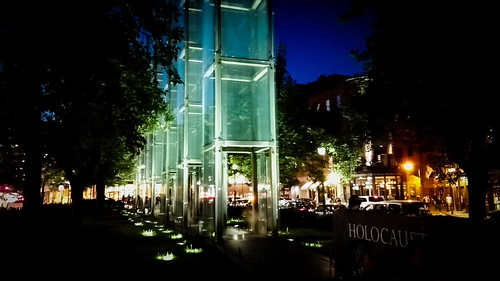Breslau 1941: clandestine photos tell of the Holocaust’s upheaval and terror
Holocaust #Holocaust

A remarkable series of photographs of Jewish families being forced to leave their homes in Germany in the middle of the second world war has been published for the first time, following a chance discovery.
The images are a striking new testament to the sudden upheaval and terror of the Holocaust and were taken secretly by an amateur photographer. He is believed to have wanted to pass down the scenes he was witnessing, despite the risk to himself. They show groups of people gathering outside a restaurant near the railway station in the Silesian city of Breslau, now Wrocław in Poland. Jewish men, women and children of all ages were held here for a few days before deportation by train. Almost all are certain to have been killed just a few days later in a documented shooting in Lithuania. Others were killed at a later date in Poland.
Steffen Heidrich, the German historian who recognised the images in a large cache of other photos, told the Observer this weekend that he hopes that any surviving friends and younger relatives may help to identify some of those pictured. Several have already been recognised.
Jewish residents assemble with their bundles of luggage on 21 November 1941 in a city square in Breslau. Historian Steffen Heidrich says the men, women and children were unlikely to know their fate. The international research project #LastSeen has made all the photographs available on its website. Photograph: © Landesverband Sachsen der Jüdischen Gemeinden
“They look quite calm. It seems clear they did not know they were about to be murdered,” said Heidrich. “This was fairly early in the history of these deportations and so they obviously did not expect it.” Heidrich found the previously unseen photographs in an archive in Dresden that was being catalogued by researchers.
The images are being revealed for the first time now to mark today’s International Holocaust Remembrance Day and the international research project #LastSeen has made them available on its website. Anyone who recognises a face in one of the scenes should contact the project by email, said Heidrich. The German research is being run by the Freie Universität in Berlin, which holds a library of hundreds of other photos documenting the expulsions that were carried out by the Nazis.
Twelve of the Breslau photographs were taken in November 1941. An additional image was taken in April 1942. They show the deportees carrying bundles of luggage, surrounded by piles of suitcases and armed Gestapo secret police.
As the Jewish residents assemble in Breslau, a German policeman with a rifle partially obscures the Gestapo head of operations behind him. The international research project #LastSeen has made all the photographs available on its website. Photograph: © Landesverband Sachsen der Jüdischen Gemeinden
“When I first picked these photographs up it was an electrifying moment,” Heidrich said. “It was clear they were scenes of a deportation. I Googled the name of the restaurant to confirm the location. The other photos, most of which are in a very poor condition, were of Jewish life in the DDR [the former East Germany], or of Jewish life in Dresden before the Shoah [Holocaust], so it was unexpected to find the deportation scenes there.”
The photographer, who is believed to be architect Albert Hadda, took his shots clandestinely through a wall or through a car window, according to Alina Bothe, director of the university project. “The accidental and sensational archival discovery opens new perspectives on the expulsion of the Jews who were persecuted in Breslau,” she told Israeli newspaper Haaretz this weekend.
On 21 November, 1941, more than 1,000 of Breslau’s residents were arrested by the police and led to the pictured restaurant. After four days they boarded trains to Kovno, in Lithuania. On arrival they were shot to death, with no known survivors. In 1942 on 9 April, almost 1,000 Jews were once more rounded up at the same restaurant, before being transported by train to Izbica in eastern Poland. Two people on this later transport survived.
Jewish residents arriving and assembling before deportation, probably taken secretly from a truck by architect Albert Hadda. The international research project #LastSeen has made all the photographs available on its website. Photograph: © Landesverband Sachsen der Jüdischen Gemeinden
Researchers believe Hadda had access to the area where the expulsions were arranged, a section of the city forbidden to the general public. From 1934, his Jewish status meant he could not work as an architect, but he avoided expulsion and death due to his marriage to a non-Jewish woman. He found part-time employment for the Jewish community in Breslau, including overseeing shipments. In 1944 Hadda was deported to a labour camp but escaped back to Breslau, where he hid until liberation. He went on to live in Frankfurt, working for Bauhaus founder Walter Gropius. He later emigrated to Israel.
This article was amended on 28 January 2024 because an earlier version said, in relation to a transport on 9 April 1942, that “it is not known whether anyone survived”. In fact two people survived. Also the research project was described as a German one, whereas it is international.